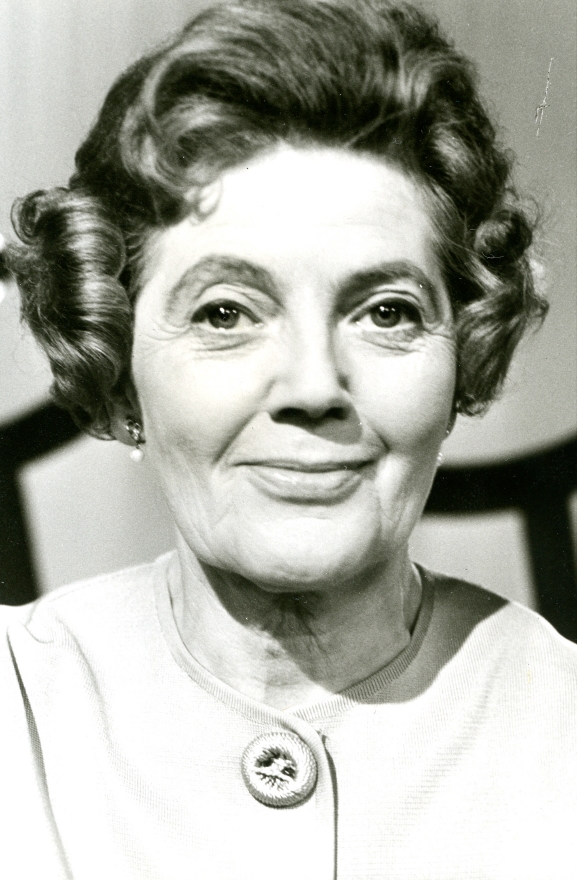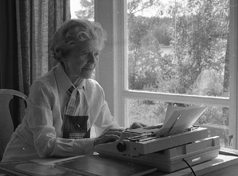Author/screenwriter Dagmar Edqvist (at times spelled Edquist) graduated in Stockholm in 1922. Her collaborators include Ingmar Bergman, Hasse Ekman and Sven Nykvist.
A small handful of authors become classics, with their acknowledged place in literary history. The vast majority have their heyday and their devoted readership for a few decades. Then they are forgotten. Dagmar Edqvist belongs to the latter category. Her debut came in 1932 with the novel Kamrathustru (“Companion wife”), which became a great and controversial success. In the 1984 edition of the Litteraturhandboken literature encyclopaedia her authorship is summarized as follows: “Sober and intelligent novels, in which modern people and modern marriages are portrayed with feminine warmth, good psychology and factual storytelling technique.”
The light-hearted film production of the 1930s showed no interest in her work, but with the outbreak of World War II and Anders Henrikson’s film adaptation of Sigfrid Siewert’s Ett brott (“A Crime”, 1940), a newfound interest in a more serious film production – as well as in Dagmar Edqvist’s writing – arose. First on the ball was not unexpectedly the visionary producer Lorens Marmstedt, who quickly obtained the film rights to both Kamrathustru and her second novel, Rymmare fast (“Fugitive caught”). During just one year (1941-1942), four films premiered in which Dagmar Edqvist was more or less involved.
First out, and least successful, was Anders Henrikson’s film adaptation of Kamrathustru, which was named Livet går vidare (“Life goes on”) for the screen. The screenplay was by Henrikson and Bengt Idestam-Almqvist and Edqvist was never consulted, which also led to the female perspective disappearing and the story being simplified and trivialized. Significantly better was Gunnar Skoglund’s En kvinna ombord, (“A woman on board”), where Skoglund and Edqvist together radically reworked the original story, the novel Rymmare fast. It was inspired by Edqvist’s journey to the Mediterranean Sea on a cargo steamer in the winter of 1933, but now the plot was moved forward, “out of consideration for the current situation”, as Marmstedt put it, to a cargo steamer facing bomb threats and minefields returning home from the Mediterranean Sea. Unexpectedly, the captain (Edvin Adophson) has to deal with both a female stowaway (Karin Ekelund), anxious to get home to Sweden, and a sailor, just rescued from a minefield. The latter was an element that was not included in the novel, but a young Hampe Faustman got a big breakthrough here and became the explosive catalyst in an evolving love triangle within this drama.
Around the same time, Marmstedt decided that Hasse Ekman should be aided with a dialogue writer for Lågor i dunklet (“Flames in the dark”), a task that Dagmar Edqvist solved with flying colours, and in the next film, where Edqvist acted as sole writer, she indeed received special praise for the dialogue. It was Anders Henrikson’s film adaptation of her own novel Fallet Ingegerd Bremssen (“The Ingegerd Bremssen case”), dealing with a raped woman who shoots her perpetrator in self-defence. The stern BLM critic Georg Svensson praised the work as “the contemporary Swedish film’s foremost creation (-) In fact, it is extremely unusual not only in Swedish film to see such dense and finely composed scenes as are shown here. (-) I also can’t remember that I have ever heard people speak so naturally in a Swedish film.”
Four years later, it was time for Ingmar Bergman to take on a new novel by Dagmar Edqvist, Music in Darkness, her 1946 story about a blind musician who tries to overcome his disability. Again, Edqvist was given the confidence to shape the script herself, but in Bergman’s body of work, Music in Darkness (US title Night is My Future, original title Musik i mörker, 1948) plays like a thankfully unsentimental but pale and impersonal film. Like Sonja Wigert in Fallet Ingegerd Bremssen, however, Mai Zetterling delivers a powerful and convincing performance here. As a portrayer of female characters, Dagmar Edqvist was unique in the Swedish film production of the 1940s.
But it would not be until 1965 that a new film would appear bearing her credit, which was directly linked to the new directions in her authorship, now with a focus on historical novels and an interest in Africa. The film photographer Sven Nykvist had long dreamed of making his own film about Africa, where his parents were active as missionaries and where he himself spent part of his childhood. Now he asked Dagmar Edqvist to turn his memories into words and visions and the result was The Vine Bridge (Lianbron, 1965). “Respect is what you mainly feel for his sympathetically disarming film,” wrote Leif Furhammar in SvD, while most of his colleagues were more critical towards both content and form. But once again, Mai Zetterling, this time in the part of the mother, drew a moving portrait.
Bengt Forslund (2018)
(translated by Jan Lumholdt)
Basic info
Main professions: Author, Screenwriter
Born: 1903
Died: 2000
Active: 1941-1985
Filmography
Manus:
Lianbron (1965)
Musik i mörker (1948)
Fallet Ingegerd Bremssen (1942)
En kvinna ombord (1941)
Roll:
Husmors filmer hösten 1964 (1964)
Dialog:
Lågor i dunklet (1942)
Published works
Kamrathustru (1932 )
Rymlingen fast (1933)
Filippa: Pjäs i tre akter (1936)
Fallet Ingegerd Bremssen (1937 )
Andra äktenskapet (1939)
Hjärtat söker nödhamn (1942)
Osynliga stängsel (1944)
Musik i mörker (1946)
Romeo i stallet och andra noveller (1948)
Trolldryck (1949)
Penelope väntar inte (1951)
Angela Teresas gäster (1953)
Paradisets portar (1956)
Skuggan blir kortare (1958)
Den svarta systern (1961)
Eldflugorna (1964)
Mannen från havet (1967) – Allan Nilsson skrev teatermanuset Ormkvinnans barn med boken som utgångsläge. Pjäsen hade premiär i Närs socken 2005
Mannen som kom hem (1969)
Människor på en ö (1973)
Möten i Marocko (1974)
Efter flykten (1977)
Varför kom du på ängen (1980)
Vänta på vind: en berättelse från 1600-talets slut (1985)

